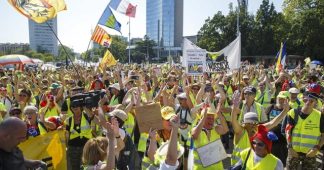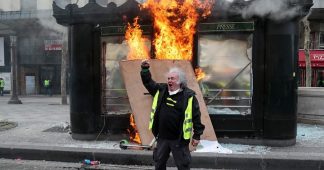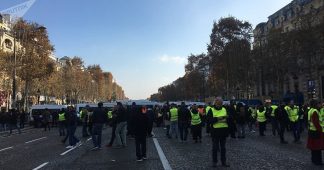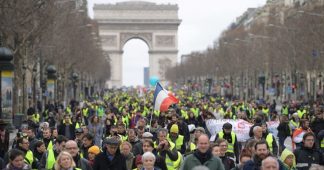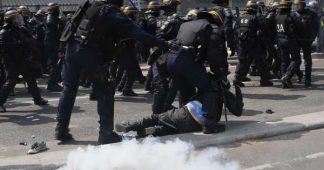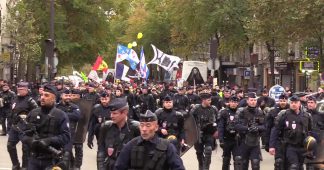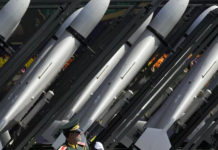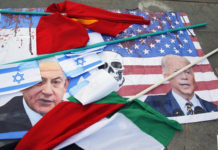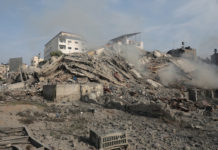Two years since the start of France’s gilets jaunes movement, hundreds of arrested protesters are languishing in prison, and dozens are still coping with the loss of an eye or a limb. The Macron administration’s brutal crackdown brought a level of police violence not seen in decades — and dramatically reduced the right to protest.
By André Kapsas
Nov. 17, 2020
photo: Gilets jaunes protesters in Paris, France on November 24, 2018. (Flickr)
But if in the very first days of the movement the authorities vacillated, before long they turned to crude repression. Week after week over the next year and more, the gilets jaunes took to the streets — and the police met them with increasing brutality. “Only” one person was killed, but hundreds were left with serious, even permanent, injuries; over eleven thousand people were arrested; and at least several hundred are still in jail. Through their response, French authorities introduced new norms of judicial repression — both dramatically and permanently restricting the room for democratic protest.
“Worse Than May ’68”
The protests that began two years ago were initially triggered by a planned fuel tax hike. At first, the participants mainly came from less urban areas, where cars are essential means of transportation for many working people. The local roundabout blockage became the meeting point for dissatisfied citizens, donning the yellow vests obligatory for road users (but also many workers), while massive Saturday demonstrations took place in the cities.
Antoine got involved in the local gilets jaunes protest in a small town in eastern France. For him, the protest was “definitely against the tax and the hit to purchasing power, but it extended to issues of democracy, local empowerment, and fiscal inequalities. It was not anti-capitalist as such, but anti-capitalist views from people like me were well received.”
Asymmetrical Violence
“The police forces’ violent reaction was completely disproportionate,” lawyer Arié Alimi tells me over the phone — emphasizing that the gilets jaunes mostly attacked objects, while the police attacked people. For seventeen years an ardent defender of victims of police brutality, he talks with indignation about the “thousands and thousands of people injured, with considerable physical and psychological traumas.” Advocacy officer on civil liberties at Amnesty International, Anne-Sophie Simpere agrees, describing the police reaction as “illegitimate, unnecessary, and completely disproportionate.” She calls the events in December 2018 a rapid “intensification of previously existing, worrying trends in the policing of demonstrations” — citing the use of weapons and a switch from crowd control to aggressive arrests that cause serious injuries
For Gassiot, the police violence obeyed the political strategy of a government full of “class contempt” for rural, lower-middle-class, and poor protesters. “They thought they’d strike a good blow on their mug, and these plebs would go back in their hole,” he sarcastically notes. A veteran radical left activist, the sixty-five-year-old has no doubt that “police violence is on a level unseen since the 1970s, worse than May ’68″ when France was on the brink of revolution. “It was like the war in Algeria, but without the dead,” he says — drawing parallels with the state violence of sixty years ago, when police killed dozens, if not hundreds, of Algerians and French communists on the streets of Paris during the colonial war in Algeria.
Bringing the War Home
The infamous Brigade anti-criminalité (BAC) best illustrates this gradual importation of methods of colonial policing into the French mainland, moving first into the banlieues — the working-class suburbs heavily populated by people with a migrant background — and finally extending them across the whole population. As Alimi stresses, it was a former senior civil servant in the colonies who set up these brigades in Paris and its suburbs in the early 1970s. “The BAC were brigades created specifically for Algerian migrant populations,” he explains.
Alimi invokes the long history of police violence against the workers’ movement, saying that we should properly speak of “contemporary police violence, with new methods.” For him, “the working-class suburbs were a laboratory for new practices of police repression introduced by the BAC, with new arrest techniques, permanent control, racial profiling, and new weapons like the flash-balls and grenades. . . . The poor migrant populations were guinea pigs for those methods, that then spread to political activists, social movements, and now to protesters in city centers.” The main architect of this shift was Nicolas Sarkozy, interior minister when he replaced neighborhood police with intervention units like the BAC in 2003, before becoming president in 2007.
“State Illegality”
In addition to police brutality, the state moved in to curtail the movement with mass arrests of thousands, judicial harassment, and illegal tactics. Simpere speaks of “very repressive laws that allow almost anyone, including peaceful demonstrators, to be arrested, often ‘preventatively.’” More specifically, she points out the use of two vaguely defined laws that she considers contrary to international law: one punishing the “preparation of group violence,” under which many people with protective gear like goggles have faced judicial persecution; and one forbidding “contempt toward police forces,” used more than twenty thousand times in 2019 alone. She cites the case of protesters in Narbonne prosecuted for this offense, simply because they had a banner denouncing the severe injuries caused by flash-balls.
In early December 2018, the authorities started to widely disregard their own laws. Alimi calls it “state illegality,” a concept he plans to elaborate in an upcoming book: “The state itself becomes criminal,” he explains, “as its representatives decide to deliberately violate the law to prevent the expression of civil liberties.” In addition to mass preventive arrests and illegal searches, he names the case of a state prosecutor calling on his substitutes to keep people in custody for the maximum length in order to prevent them from demonstrating, despite having no evidence against them. “France shifted from a justice system that punishes actions to a justice system that punishes intentions,” he says.
This judicial repression has led to unprecedented numbers of arrests, with more than eleven thousand detained and more than three thousand convicted. “The courts were working like a production line,” recalls Gassiot, “with speedy trials on Mondays for those arrested on Saturdays.” Alimi counts about seven hundred to eight hundred gilets jaunes currently in jail — and he has himself defended many of those arrested. “They have been victims of an incomparable judicial violence and discrimination; they’ve been treated like animals,” he says. Unusually for France, even people with no criminal records were sentenced to jail time. “They were lower-middle-class people endangered by poverty; they were simply trying to keep their head above water, but they were pushed down — and drowned.”
Police Impunity
This swift and merciless justice against the gilets jaunes contrasted with the lack of judicial reaction to police brutality. Despite the thousands of acts of violence against protesters — many of them proven by solid video evidence — the available information reveals that only seven police officers have been convicted. All of them received suspended sentences, with no discharge. Simpere describes the cases as “largely symbolic,” expressing her “serious doubt that there will be sentences corresponding to the seriousness of injuries.” Alimi is less diplomatic, calling the few convictions “crumbs thrown to the people to calm popular anger.”
During the first months of the crisis, as blood was being spilled every week, the government maintained a hard line in denying the existence of police violence, even refusing to use the word. Challenged on the issue by a citizen during a debate in March 2019, President Emmanuel Macron snapped back: “Do not talk about repression and police violence — those words are unacceptable in a state with the rule of law!” According to widely respected French daily Le Monde, citing insider sources, this unshakable political support for repression came from a genuine fear in December 2018 that rank-and-file police might abandon their post — and let the uprising prevail.
While the climate of police impunity might be linked to the high political stakes, my interviewees note that this lack of accountability has been pervasive for decades. The “police of the police” — the infamous Inspection Générale de la Police Nationale (IGPN) — is widely derided as a “whitewashing machine,” systematically clearing up on behalf of its colleagues. Simpere points out that “there is a clear conflict of interests when police officers have to monitor other police officers, and also when magistrates who are working in close collaboration with the police are the ones who are supposed to lead investigations against the police.”
A Cynical Commemoration
In a cynical twist, this year’s second anniversary of the movement is marked by government plans to pass a new “Global Security Law” which will greatly extend police powers. It also wants to ban the circulation of images of police interventions, if this “aims to cause physical or psychological harm” to officers. In practice, such a catch-all restriction will block any circulation of amateur videos of the police. The law also stipulates a dramatic extension of police rights to surveil, including the deployment of drones. “We’re moving toward an authoritarian democracy, where the state can see without being seen, where state violence is tolerated despite being illegal,” says Alimi.
As for the gilets jaunes, police repression severely broke the back of the movement in the first six months. Yet protests continued even afterward, building ties with other social struggles, like in recent demonstrations against the pension reform or alongside health care workers. Yet a climate of fear established by the government has dissuaded many from demonstrating. As Julien says: “It’s freaky when you’re at a demonstration and you hear the distinctive smacks of flash-balls; people start panicking.”
But today, on the two-year anniversary of the movement, the activists I spoke to will be in the streets to demonstrate against new repressive laws. When I ask them for an overall assessment of the movement where many of them met, they tell me: “It was beautiful!” “Yes,” Louise jumps in, “and it’s still going on!”
Published at jacobinmag.com
